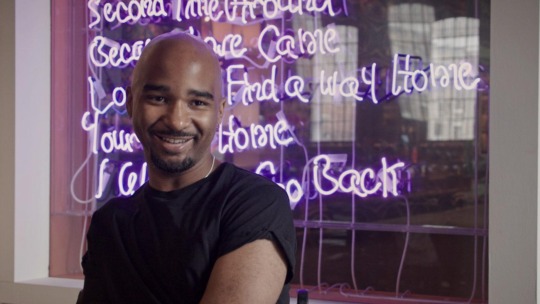
For all the heat airlines are taking these days for their stripped-down services, the airports that their customers fly in and out of have, in recent years, steadily improved the flying experience. International airports now resemble high-end malls, with luxury shopping and boldface dining destinations. Some airports, like Phoenix Sky Harbor and San Francisco International (SFO) both feature certification from the American Association of Museums in their terminals as a way to engage travelers passing through. Today airports want to offer a complete cultural experience to provide a glimpse of what makes their city awesome.

At Atlanta’s Hartsfield-Jackson International (ATL), the Airport Art Program has been around in some fashion for decades, staging big shows without museum certification. SFO is unique in that it can host shows that might also appear at such major institutions as the DeYoung in San Francisco or the High Museum in Atlanta. For an airport to receive certification means it has the staff (including curators, registrars, etc.) as well as special climate-controlled and secured display cases for the art. ATL, like most other airports, don’t have the giant art budget that SFO has, and instead focuses on curating its own shows from artists in their area. It’s also worth noting that upgrading display cases to museum-quality standards is cost-prohibitive in a mega volume airport like ATL, so don’t expect a big Picasso show there any time soon.

So many people travel through the Atlanta airport (more than a quarter million daily), that the installation of artwork cannot take place during peak travel times. The work happens during the graveyard shift. Security poses another big challenge for installing art at any airport. Large, complex sculptures have to be taken apart and moved through security piece-by-piece. The art goes through the same scans—X-ray and explosives swab— that passengers experience. Once all the pieces of an artwork are cleared by TSA, installation can begin.

While Hartsfield-Jackson doesn’t have museum certification, it does have an impressive permanent collection, which includes work from the exhibition “Zimbabwe Sculpture: A Tradition in Stone.” Twenty sculptures by 12 artists were purchased by the airport in 1999 after art program managers traveled to the country to conduct studio visits and meet with artists. This collection is displayed in the underground walkway between terminals. Successive leaders of the Airport Arts program have shaped the permanent collection. The current administrators are David Vogt and Benjamin Austin. For more than a decade, Katherine Dirga (now leading arts at MARTA) brought her leadership. Permanent collection does not always mean permanent installation. Very controversially, Joe Peragine’s ants were removed for renovations.
Another permanent piece was a milestone for the Atlanta artist when it was commissioned and installed in 1996. Radcliffe Bailey’s Saints is a mixed-media installation using paint, stencil, and found images made especially for a curving wall over an escalator bank in Terminal E.
Lately the Atlanta airport has stepped up its large-scale installation game. Past MacArthur fellow Ned Kahn is currently in the design phase of a monumental commission that will cover part of a new long-term parking deck under construction in nearby College Park. Last year, Airport Art Program unveiled a $4-million dollar installation 13 years in the making. Between Terminals A and B, the massive Flight Paths by Steve Waldeck evokes a sense of walking through a forest. A canopy of cut metal combined with special lighting turns the ceiling into a jungle. Projections, such as flying birds, and forest sounds, create a full sensory experience.

Although the airport does not act as a gallery or sales agent for artists, there have been instances when passengers fell in love with an artwork they saw at the airport, and ended up buying it. Pieces by Athens artist Mary Engel, who is represented by Marcia Wood Gallery, were purchased after being shown in display cases on Terminal E. One was titled Gold Bison and was purchased by a local collector who saw a new piece they had to have. These sculptures were originally a part of the exhibition “Ceramix,” curated by Hope Cohn, but did not include sales information. The buyer contacted Marcia Wood, whose gallery was credited, and purchased the piece through her.

The next time you are in ATL, walk to your terminal instead of taking the train. You will find a wide range of inspiring artworks. In case you are delayed, hit up Terminal E for a full museum experience. Pieces are marked with placard information, but you may find yourself stumbling onto pieces you wouldn’t expect in an airport. Each gate has something different, and many pieces are tucked into corners or hanging from the ceiling. The administrators behind the Airport Art Program continue to introduce travelers to Atlanta artists, one transfer at a time.
Matthew Terrell writes, photographs, and creates videos in the fine city of Atlanta. His work can be found regularly on the Huffington Post, where he covers such subjects as the queer history of the South, drag culture, and gay men’s health issues.
A Reason to Spend More Time at the Airport, On Purpose
Related Stories
Reviews
Art21 x Burnaway
Mood Ring
Everyday Love by Richard Dial at Institute 193, Lexington
Daniel Fuller reviews the crafted metal chairs reflecting tenderness and the human condition in Everyday Love by Richard Dial at Institute 193, Lexington.
The Incredulity of Jacolby Satterwhite
In April's Art21 x Burnaway feature, we enter and explore the resurrection, rebirth, and regenerative quality of Jacolby Satterwhite's virtual worlds.
How To Get Free
Pieced together through collage, video capture, and a spoken poem, artist Kay-Ann Henry presents the intricacies of Afro-religious practices and Jamaica's particular expression of obeah, pocomania, and kumina.




